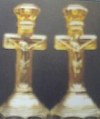Idyll & Roses with Ivy & Holly
A SCHEME OF- IDYLL and ROSES, with a side of IVY and HOLLY
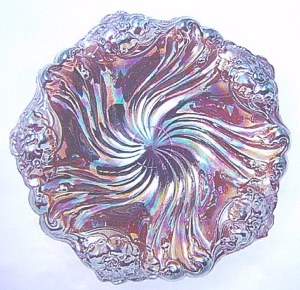 |
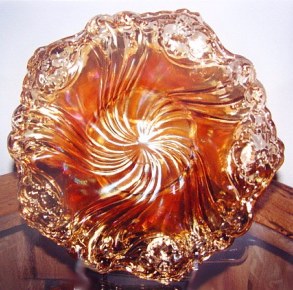 |
Amethyst Rose Pinwheel
|
Marigold Rose Pinwheel
|
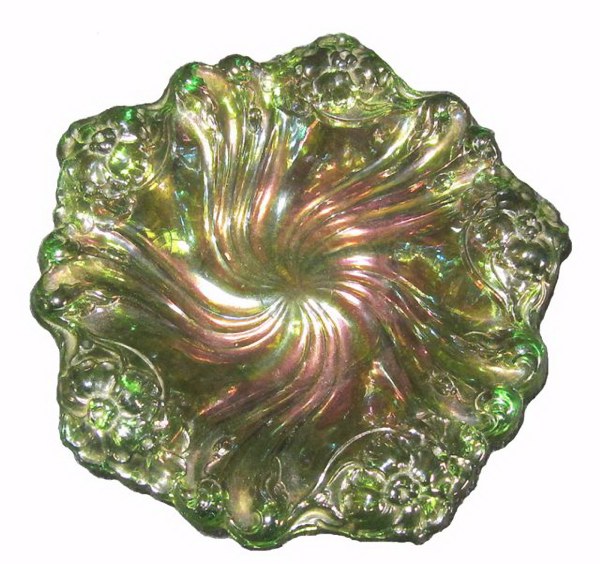
2nd known Green ROSE PINWHEEL 9 in. Bowl. Sold Sept. 2012 for $1300.
ROSE PINWHEEL
At one time this lovely marigold Rose Pinwheel bowl was in the collection of Norene and Tony Duran of New Mexico.
Some of you collectors may never have seen one of these pieces and very little written information about the pattern has been recorded over the years. Found only in 9” bowls, the glass is quite thick and heavy with the roses on the edge, indented on the backside, similar to the Rose and Poppy Show pieces. The name is aptly applied; resembling a pinwheel with roses overlapping the edge.
Speculation has it that perhaps manufacture took place in a Scandinavian country. The late Don Moore felt that perhaps the same producer gave us the couple of known Roses and Greek Key plates, although the latter is much more detailed and elaborate. Others feel that the two patterns are unrelated.
As nearly as research can pinpoint: there are three marigold bowls, 2-3 amethyst bowls and 1 green bowl. Reports are that a fourth amethyst bowl is in British Columbia.
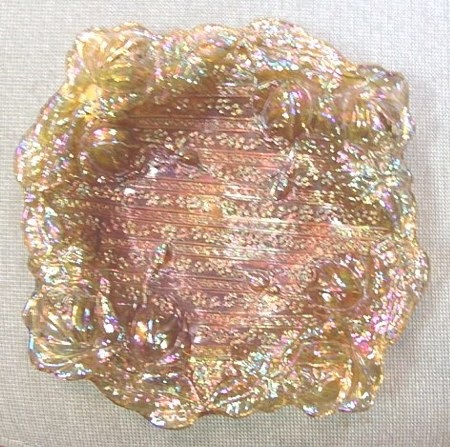
SMOKEY AMBER *ROSES AND GREEK KEY* PLATE
According to the article written for the April 1998 issue of the San Diego County Carnival Glass Club newsletter about this “one-of-a-kind”, by Jack Adams, it was in the Joe Corothers collection in the fall of 1980, when George Loescher called to say they were planning to sell most of their collection. At that time, Jack states that according to Mary Adams, this is the #1 piece in that collection, and as far as he was concerned, it was rated #3. At any rate, they decided to go as high as they can afford when calling Corothers’ to ask about buying the plate. $5,000 was the agreed price. However, in making the call, Joe told Jack the price they were asking was $5100! (Jack casually agreed).
Now, in 1998, as Jack recalls the incident, he and Mary still regard this Smoky plate as #1 in Carnival Glass, relatively unknown and underappreciated as it is.
While the maker remains unknown, the Adams’ traced their plate back to the 1950’s when Leona Gilmore, (Emma Tilton’s mother) bought it. Louise Espenschied then bought the plate and showed it to Rose Presznick, who drew an excellent illustration in her 1965 Carnival and Iridescent Glass Book III (plate 119-page 31).
Mrs. Presznick said she’d seen two, “a smoky amber” and “a smoky deep blue”. People have called our plate smoky amber, but never a deep blue. She may have been counting the same piece twice because looking at the plate from the bottom, one might think smoky bluish.
Charlie Thrawley of Indiana, bought it from Louise Espenshied. His auction was the major Carnival sale of 1969. Wiley Addis, long time ACGA member and officer, bought it for $650. In 1971, Wiley wrote, illustrated and published his own booklet of patterns on the reverse side of the major pattern. Titled What’s Behind Old Carnival?, he put the Roses and Greek Key reverse pattern on the cover. This is also Roses and Greek Key, so the pattern is molded into both sides of the plate.
He then traveled to Emporia, Kansas, where he showed it to Marion Hartung. She drew an illustration for her 1973 Tenth Book of Carnival Glass (page 103). Unfortunately, with advancing age, her illustrating skills were beginning to slip. She did state that the color was “a variety of smoky marigold”.
In May, 1972, Wiley Addis sold the plate and some 20 others to the Corothers’ for a reported $5000. At the time, Mary and Jack thought: Oh, what a bargain!
This intensely smoky plate measures 10 ¼” from tip to tip diagonally but Jack does not classify it as a chop plate, nor a normal type plate.
After intense study, he declares the base glass to be clear. The iridescent finish is not the same as any other seen in Carnival from San Francisco Bay to Long Island, from the Northland to Victoria, Texas. The iridescence is all on the top surface, and not comparable to any other iridescence the Adams’ have seen. Mary will get mad at you if you dare to call it marigold! It might be called “jeweled smoky-amber”, but even that descriptor is lacking. A mold line on the undersurface, goes all the way around the edge, of about ½ inch. It must have been very difficult to get out of the mold and iridized without damaging the pattern. Jack says he has never seen another piece molded in the exact same way.
Frank Fenton told Jack that they never made just one of any piece, even if it was a sample. Considering all the work that went into creating this piece, it is hard to imagine that only one was made and they did NOT, as Nola Schmoker found out in Oct. of 1997. Take a lesson from her experience. When she was told about the plate, she knew right away what it was, as she had seen the Adams' smoky plate in a HOACGA Convention display along in 1985. The Adams' had taken it there for Frank Fenton to see. The plate made a big impression on Mrs. Schmoker as it had on us the first time we saw it.
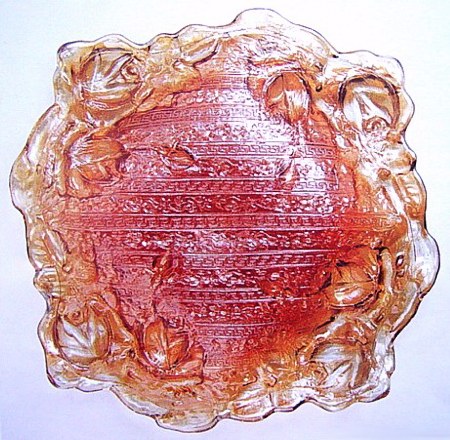
MARIGOLD *ROSES AND GREEK KEY* PLATE
There is a difference in the type of iridescence on this plate. It has a deep, rich, excellent finish. This example is 8 ½” across and 10” from corner to corner. On the front are three roses in each corner and ten rows of flowers 3/8” wide. On the back, the roses are indented like the Rose Show pieces. It has a domed round base with no collar. There are ten rows of flowers 3/8” wide with nine rows of Greek key design ¼” wide.
Nola and Keith Schmoker drove from Wichita, KS to Florida, some 2400 miles to pick up this purchase. The seller had bought the piece at a Florida auction in 1995, where 20 other pieces of Carnival at prices of $20-$30 each also sold.
The lady noticed an ad for the Air Capitol Convention in the Antique Trader, called Don Kime, asking whether he or anyone he knew might be interested in purchasing this plate she had in her glass cabinet. Don passed the word to Schmoker’s.
“When opportuniy knocks—answer the door,” as Jerry Curtis commented.
Schmoker’s have since sold the marigold plate. The Adams’ smoky amber plate sold in St. Louis on Nov. 22, 2003, when Seeck's sold their collection. The selling price was $17,000 and the plate now resides in the Randy and Jackie Poucher collection in Florida.
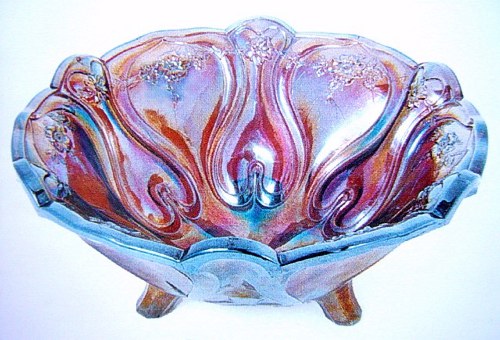
DOZEN ROSES
As you would suspect, twelve roses surround the inside rim of this unusual footed bowl. The loop effect used around the inside of the bowl creates quite a nice result in offsetting the roses. Maker is unknown. The pattern offers rather a heavy but attractive motif. Exterior carries a modified wide-paneled design with three small feet, rather like the ones found on Imperial’s Floral and Optic pattern. An amethyst bowl sold in 1997 for $1100. A marigold example having some damage on the edge brought $250 in 1997. The most recent sale was for a round purple bowl at $900 in 2003.
Somehow this interesting piece lends similar tendencies offered by the Roses and Greek Key pieces and the Rose Pinwheel. What do you think?
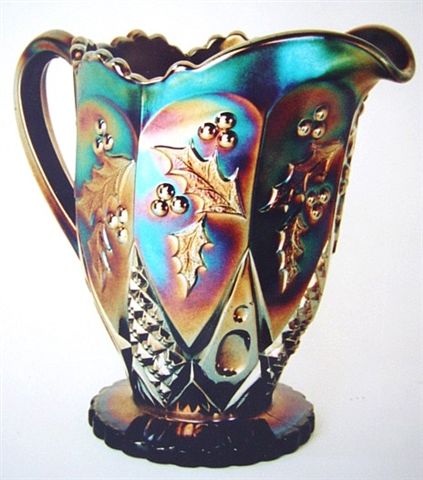
PANELED HOLLY PITCHER
This article was written by George Loescher for the Feb. 1998 Southern California Club newsletter.
Many collecting years ago – 25 or more, I got wind of a very nice collection of carnival glass in Ohio with several items for sale. I went to the bank, got some money (borrowed, probably), got in my Pinto and headed for Ohio. There were many nice things available, one being the pictured Paneled Holly pitcher. I didn't buy it immediately but went home and looked it up in Ms. Presznick’s books. Then I called the lady back and asked how much she wanted. We agreed on a price of $250. At that time, I did buy it along with some other very nice items; a marigold Christmas compote being one.
Bill Richards, Sr. previously had purchased this pitcher and a blue Butterfly and Berry pitcher from a person in Ohio. He later sold it to the lady I purchased it from.)
When I returned to Beloit, Wisconsin, with the pitcher, I washed it and Mavis dried and polished it. Then she discovered the “N”. This was a thrill back then because when you had an N, you knew it was Northwood—no guessing involved. This pitcher has been in our collection all these many years. To date, I've never heard of another. In fact, I've never seen any of the Paneled Holly pattern in purple/amethyst carnival glass. You will find the bon-bons in green and marigold. At auction, only 5 have sold in green since 1984 and only one marigold in 1992. This pattern is seen in opalescent glass in water and table sets. In fact, we have the pitcher in blue opal as well (not carnival).
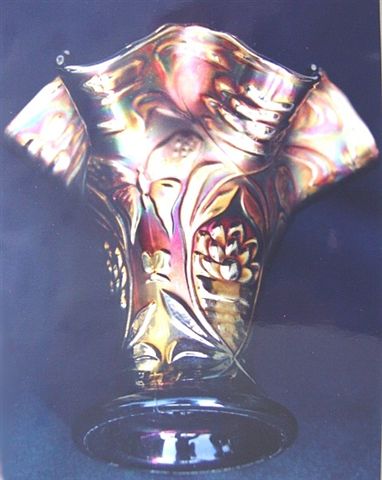
IDYLL VASE
As written by Bob Patterson for the May 1998 Southern California Club newsletter.
It is a delight to feature this rare vase, partly because there never has been a good photo published. Webster defines IDYLL as “a short poem or prose work describing a simple, pleasant scene of rural or pastoral life” or “a scene or incident suitable for such a work”. That description pretty well sums up the feeling one gets from viewing this work of art.
Only a couple each are known in amethyst and in marigold. A marigold with sides sloped upwards into a slight flare at the top sold in 1993 for $600. No other colors have ever been reported. The featured example is amethyst with very nice iridescence. It has a satin finish at the top and radium type finish near the base. The collar base is plain and measures 3 5/8” in diameter and the height and width is 6 ½”, which makes for a very pleasant shape. It is reported to be a Fenton product and the color of the glass, iridescence and motif of Butterflies and Waterlilys all point in Fenton’s direction. However, its a mystery to me, why such a beautiful vase was made in such limited numbers? Also, what ever happened to the mold if it was Fenton’s?
Perhaps someone out there has some answers? This example is not a new find, as I acquired it from a couple who started collecting carnival glass many years ago. They purchased it in April of 1964 at a show in Indiana for $9. At that time, these vases were listed in Marion Hartung’s price guide at $32. The vase was in their care for 34 years and now I hope to watch over it for at least that long.
If you ever locate one for sale, buy it! You may never get a second chance! Happy Hunting!
Conjecture by Diane Fry: Perhaps this vase mold was developed as an accompaniment to the Waterlily and Cattails family of Fenton products, but was only produced in experimentation, never going into full production? The Waterlily and Cattails line of products is among the oldest found in the Fenton line, and is found mostly in marigold carnival glass. There are three sizes in tumblers known in that pattern, circa 1908. In addition: amethyst opal, green opal, blue opal, and white opal pieces were being made in this pattern in 1907. Prior to that, Jacob Rosenthal, a member of the Fenton Family developed 8 different shapes in Waterlily and Cattails pattern for use in his newly developed formula for chocolate glass. These are shown on page 29 Fenton Glass-The First Twenty-Five Years.
Note: There are no butterflies in the Waterlily and Cattails pattern. That is where the IDYLL vase design parts company.
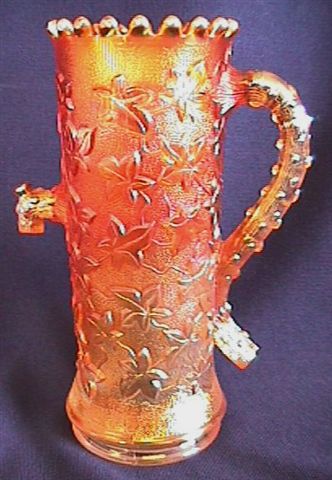
IVY TOWN PUMP
This novelty item was produced by Northwood Glass Co. in Wheeling, WV. It is a design variation from the opalescent pump and trough made by Harry in Indiana, PA prior to the production of Carnival Glass. A similar item had been produced in the mid 1800’s in the Stourbridge area of England where Harry Northwood had come from.
The pump stands 6 ¼” high and sits on a collar base. The design of ivy leaves and vines on the central part of the vase corresponds nicely with a tree bark design found on the handle and pump section. Small hobnails are a part of the pattern, as well, lending a rustic appearance overall. The stippled under surface seems to enhance the detail of the ivy. The interior of the pump is plain except for the N mark on the bottom.
Iridescence on the marigold examples offer many pink, blue and green highlights with even distribution to the base. Marigold is not a color often available to the buyer. In fact it could be considered rare. Green is another rare color. The purple pump is the most frequently found color. We can fantasize about an ice blue one!! The unusual and shapely design of this piece blends nicely with any collection of bowls, plates and vases.
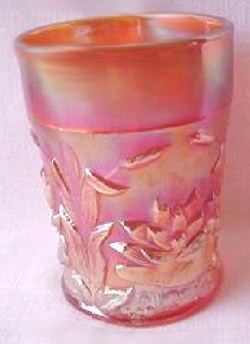
WATERLILY & CATTAILS TUMBLER
We only have the marigold tumbler to show you, having waited many long years for a pretty pitcher to go with! Although the pattern was made in other types of glass during the 1907 and 1908 period, very little of the marigold iridescent becomes available for Carnival Collectors today. We once saw a complete marigold table set when (still too green to KNOW we should buy it), and have owned and sold a very nice large berry bowl in marigold.
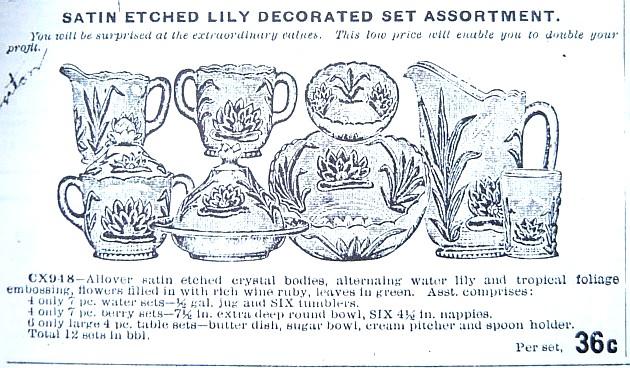
BUTLER BROS. AD FROM 1908 SHOWING WATERLILY IN CRYSTAL PIECES
D/D Fry~~~6/04
   |
|
“DIRECTIONS TO OUR FATHER’S HOUSE”
Make a Right onto Believeth Blvd.
Keep straight and go through the Green Light, which is Jesus Christ
There, you must turn onto Bridge of Faith, which is over troubled water.
When you get off the bridge, make a Right turn and Keep Straight.
You are on the King’s Highway – Heaven-bound.
Keep going for three miles: One for the Father, One for the Son, and One for the Holy Ghost.
Then exit off onto Grace Blvd.
From there, make a Right turn on Gospel Lane.
Keep Straight and then make another Right on Prayer Road.
As you go on your way, Yield Not to the traffic on Temptation Ave.
Also, avoid SIN STREET because it is a DEAD END.
Pass up Envy Drive, and Hate Avenue.
Also, pass Hypocrisy Street, Gossiping Lane, and Backbiting Blvd.
However, you have to go down Long-suffering lane, Persecution Blvd. and Trials and Tribulations Ave.
But that's all right, because VICTORY Street is straight ahead!
AMEN!!!!
Life is God’s gift to you.
The way you live it………is your gift to God.
|
|
   |
Should you care to contact the Frys, their email address is:
Search Our Sites
back to Carnival Glass 101
Our other sites you may enjoy:
Everything you EVER wanted to know about Indiana Glass
Great Reference for Newer Carnival Glass.
Complete Glassware Catalogs Available to Download
Questions? Comments? Suggestions? Broken Links? Corrections?
Your Friendly Webmaster is here to help!
